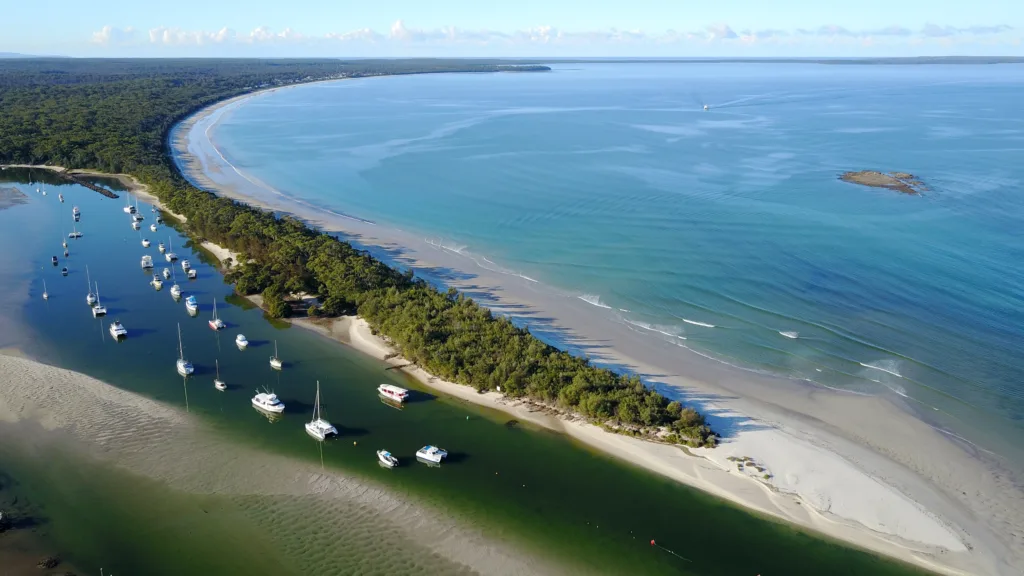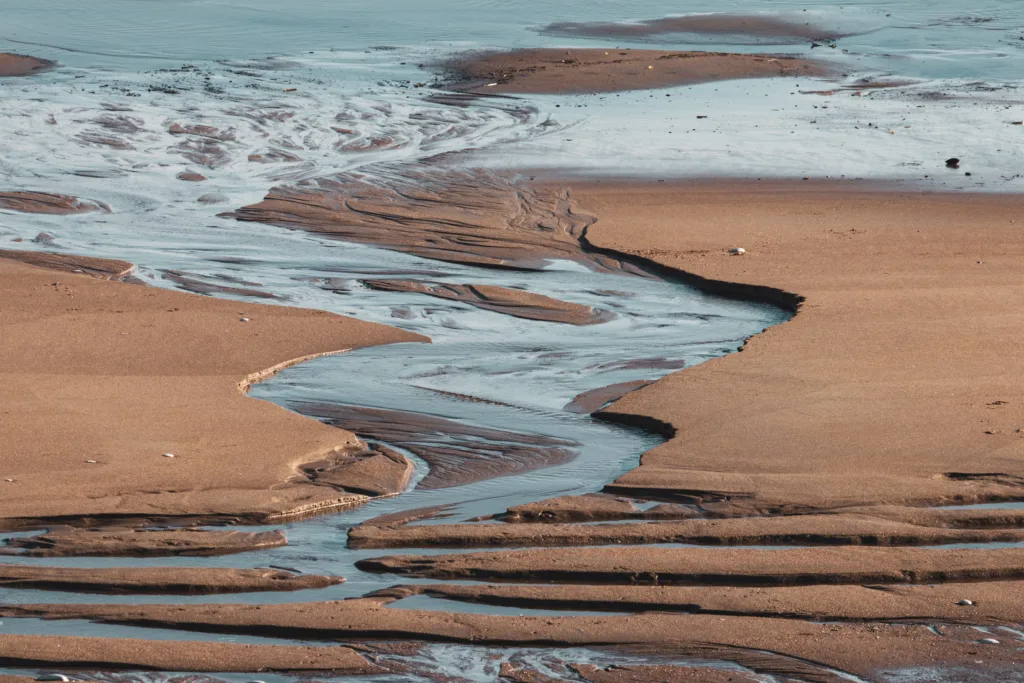Spits are fascinating coastal land formations that occur when there is a change in the shape of the landscape or the presence of a river mouth or estuary. These narrow stretches of land jut out into the sea from the land, creating a unique and dynamic environment.
The formation of spits is closely tied to the process of longshore drift. This natural process involves the movement of sediment along the coastline by the action of waves and currents. Imagine pulling a lollipop out of your mouth and noticing the saliva dripping down the stick. This is similar to how sediment is carried by longshore drift. The waves and currents pick up sediment, such as sand or shingle, and transport it along the coast.
Spits often form where the coastline abruptly changes direction or across the mouths of estuaries. They can also develop from each headland at harbour mouths. These areas are prone to the accumulation of sediment carried by longshore drift, leading to the formation of spits.
The process starts with the waves and currents carrying sediment along the coastline. As the waves approach the coast, they slow down and deposit some of the sediment they are carrying. This deposition occurs when the waves lose energy and are unable to carry the sediment any further. Over time, this repeated deposition of sediment leads to the gradual extension of the land out into the sea, forming a spit.
Spits can vary in size and shape depending on the local geography and the strength of the longshore drift in that area. They can range from short and stubby to long and slender. Some spits may even curve or bend due to changes in wave direction or the presence of underwater currents.
The formation of spits has important implications for the surrounding environment. The sheltered areas created by spits can provide a habitat for a variety of plants and animals. The deposition of sediment can also contribute to the formation of salt marshes or sand dunes, further enhancing the ecological diversity of the area.
However, it’s important to note that spits are not permanent structures. They are constantly changing and evolving due to the dynamic nature of coastal processes. Erosion from waves and storms can cause spits to shrink or even disappear entirely, while deposition of sediment can lead to their growth and extension.
Spits are fascinating coastal land formations that occur when sediment is carried by longshore drift and deposited along the coastline. They often occur where the coast abruptly changes direction or across the mouths of estuaries. Spits can vary in size and shape, and they provide important habitats for various plants and animals. However, they are not permanent structures and are subject to constant change due to coastal processes.
What Are Spits In Geography?
Spits are geographical features found in coastal areas. They are essentially long, narrow stretches of sand or shingle that extend out into the sea from the land. Spits are formed due to various factors, including changes in the shape of the landscape or the presence of a river mouth or estuary.
The formation of a spit begins with the process of longshore drift. Longshore drift refers to the movement of sediment along the coastline caused by the action of waves. As waves approach the coast at an angle, they carry sediment (such as sand or shingle) along the shoreline in a zigzag pattern.
When there is a change in the shape of the coastline, such as a sudden bend or change in direction, the movement of sediment through longshore drift can be disrupted. This disruption causes the sediment to be deposited in a specific area, leading to the formation of a spit.
Additionally, spits can also form at the mouth of a river or estuary. Rivers carry sediment from inland areas and deposit it at their mouths. When this sediment meets the action of waves and longshore drift, it can accumulate and extend out into the sea, forming a spit.
Spits are long, narrow stretches of sand or shingle that protrude into the sea from the land. They are formed as a result of changes in the coastline’s shape or the presence of a river mouth or estuary. The movement of sediment through longshore drift plays a crucial role in the formation of spits.

What Is Spit?
Spit, also known as saliva, is a clear liquid that is constantly produced in your mouth. It is composed primarily of water, along with a few other chemicals. Here are some key points about spit:
1. Composition: Saliva is mainly made up of water, which accounts for the majority of its content. It also contains enzymes, electrolytes, mucus, antibacterial compounds, and proteins.
2. Function: Spit serves several important functions in the body. It helps with the digestion of food by moistening and lubricating it, making it easier to swallow. Saliva also contains enzymes that begin the process of breaking down carbohydrates in the mouth.
3. Moisturizing: Saliva helps to keep the mouth moist, preventing it from drying out. This is important for maintaining oral health and preventing discomfort.
4. Protection: It acts as a protective barrier against harmful bacteria and viruses in the mouth. Saliva contains antibacterial compounds and enzymes that help to neutralize and kill bacteria, reducing the risk of infections.
5. pH Regulation: Spit plays a role in maintaining the pH balance in the mouth. It helps to neutralize the acid produced by bacteria, reducing the risk of tooth decay and maintaining a healthy oral environment.
6. Taste: Saliva also plays a role in taste perception. It helps to dissolve food particles, allowing the taste buds on the tongue to detect various flavors.
7. Speech: Spit is essential for proper speech production. It helps in the movement of the tongue and lips, enabling clear pronunciation of words.
8. Swallowing: Saliva assists in the process of swallowing food and drinks. It helps to moisten the food, making it easier to form a bolus (a compact mass) that can be swallowed smoothly.
9. Natural Cleanser: Spit acts as a natural cleanser for the mouth. It washes away food particles and debris, reducing the risk of plaque formation and maintaining oral hygiene.
10. Production: Saliva is produced by salivary glands located in and around the mouth. There are three pairs of major salivary glands: the parotid glands, submandibular glands, and sublingual glands. These glands continuously release saliva into the mouth through ducts.
Spit or saliva is a clear liquid that is continuously produced in the mouth. It serves various important functions, including digestion, lubrication, protection against bacteria, taste perception, speech, swallowing, natural cleansing, and pH regulation.
What Are Spits In The Ocean?
Spits in the ocean are narrow land formations that are connected to the coast at one end. They typically occur where there is a sudden change in the direction of the coastline. These landforms often form across estuary mouths or at the entrance of harbors. Spits can develop from each headland, creating a barrier that extends into the water.
To provide a more detailed explanation, here are some key points about spits in the ocean:
1. Definition: Spits are coastal landforms that are long and narrow in shape. They are composed of sediment, such as sand or gravel, and are typically formed by the action of waves, currents, and longshore drift.
2. Formation: Spits usually form in areas where there is a significant change in the direction of the coastline. This change can be caused by factors like erosion, changes in sediment supply, or the presence of headlands or river mouths.
3. Processes involved: The formation of spits is influenced by several processes. Longshore drift, which is the movement of sediment along the coast due to wave action, plays a crucial role. Waves approaching the coast at an angle cause sediment to move in a zigzag pattern, resulting in the accumulation of sediment at the end of the spit.
4. Estuary mouths and harbors: Spits commonly occur across the mouths of estuaries or at the entrance of harbors. The change in direction of the coastline, along with the convergence of river currents and ocean currents, can lead to the formation of spits in these locations.
5. Characteristics: Spits are typically characterized by a wider, more stable base connected to the coast and a narrower, more dynamic end that extends into the water. The tip of the spit may curve or hook, depending on the prevailing wave and current patterns.
6. Erosion and accretion: Spits are subject to erosion and accretion processes. Erosion can occur on the exposed side of the spit, while accretion takes place on the sheltered side. Over time, spits may grow longer or change shape due to these ongoing processes.
7. Ecological significance: Spits can create sheltered areas behind them, forming lagoons or marshes that provide habitats for various plants and animals. These coastal environments are often important for biodiversity and serve as nesting sites for birds.
Spits in the ocean are narrow land formations that extend from the coast and are often found at estuary mouths or harbor entrances. They are shaped by wave action, currents, and longshore drift, and their formation is influenced by changes in the coastline’s direction. Spits can have ecological significance and play a role in shaping coastal environments.
What Are Spits Made Of?
Spits are formations found along coastlines that are made up of eroded material. These elongated ridges of sediment are created through a process known as longshore drift. Longshore drift occurs when waves approach the shore at an angle, carrying sediment with them. This sediment can come from various sources, such as cliffs, rivers, or other coastal erosion.
The material that makes up spits is typically a mixture of sand, gravel, and pebbles. The composition can vary depending on the geology of the area and the sources of erosion. For example, in areas with more rocky cliffs, the spit may contain more pebbles and gravel. In contrast, areas with sandy beaches may result in spits composed mainly of sand.
The formation of spits is a gradual process that occurs over time. As waves approach the coastline, they carry sediment along with them. When the waves reach an area where the coastline changes direction or there is a change in wave direction, the sediment is deposited. This deposition occurs on the updrift side of the change in direction, forming a ridge parallel to the coastline.
Spits can continue to grow over time as longshore drift continues to deposit sediment. They can extend for considerable distances, ranging from a few meters to several kilometers. The shape and size of spits can also be influenced by other factors, such as tides and currents.
Spits are made of eroded material, such as sand, gravel, and pebbles, that is carried by waves along the coastline through a process called longshore drift. The composition of spits can vary depending on the geology of the area and the sources of erosion. Spits are formed through gradual deposition of sediment on the updrift side of changes in coastline or wave direction. They can continue to grow over time and can vary in size and shape.

Conclusion
Spits are unique land formations that occur when there is a change in the shape of the coastline or when a river mouth or estuary is present. They are formed through the process of longshore drift, where sediment is carried by the movement of waves along the coastline. This sediment, consisting of sand or shingle, accumulates and extends out into the sea, creating a narrow stretch of land that is connected to the coast at one end. Spits often occur at points where the coastline abruptly changes direction or across the mouths of estuaries. These formations play an important role in coastal geomorphology and can have significant impacts on the surrounding environment. Understanding the formation and characteristics of spits can help in the management and conservation of coastal areas.
